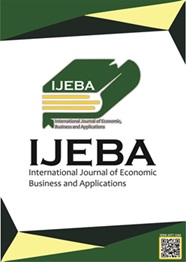The Effect Of Financial Ratio and Macroeconomic On Financial Distress On Property, Real Estate And Building Construction Companies Listed On The Indonesian Stock Exchange 2015-2019
Abstract
This study aims to examine the effect of financial ratios and macroeconomic on financial distress. Financial ratios are assessed using the ROE, DER, CR, SG, CFFO proxies and macroeconomic proxies are inflation, exchange rates, BI rate, GDP and financial distress measured by the springate model. The data used in this study is secondary data in the form of annual reports from 2015-2019 obtained from the Indonesian Stock Exchange website or www.idx.co.id and Bank Indonesia or www.bi.go.id and the Central Bureau of Statistics or www.bps.go.id. The population in this study amounted to 53 property, real estate and building construction companies listed on the Indonesian Stock Exchange with a sampling technique using purposive sampling obtained as many as 40 companies. Hypothesis testing in this study used logistic regression analysis with the help of the SPSS application. The results obtained indicate that ROE, CR, SG, CFFO, Inflation has a significant negative effect on financial distress. DER, BI rate, exchange rate have a significant positive effect on financial distress. While, GDP has no significant effect on financial distress.
Keywords
Full Text:
PDFReferences
Almilia, Luciana and Kristijadi. (2003). Financial Ratio Analysis to Predict Financial Distress Condition of Manufacturing Companies Listed on the Jakarta Stock Exchange. Indonesian Journal of Accounting and Auditing (JAAI), Volume 7 Number 2.
Antikasari, TW, & Djuminah. (2017). "Predicting Financial Distress With Binary Logit Regression Manufacturing Companies". Journal of Finance and Banking, Vol. 21 No. 2 Pg. 265-275.
Asfali, I. (2019). Effect of Profitability, Liquidity, Leverage, Activity, Sales Growth on Financial Distress of Chemical Companies. Journal of Economics and Management, 20(2), 56–66.
Astuti, RT (2018). Management of Post Traumatic Stress Disorder (PTSD) Based On Concepts And Recent Research. (SE Heni, Ed.). 1.
Bisnis.com,https://economic.bisnis.com/read/20190721/47/1126842/suku-bunga-bi- turun-ini-impaknya-ke-kpr, February 7, 2021 at 19.25 WIB
BPS (Central Bureau of Statistics), https://lokadata.id/data/percepat-economy- indonesia-2011-2019-1580884457, February 6, 2021 at 19.00 WIB.
Brigham, Eugene F, & Houston Joel F. (2001). Financial management. Edition 8.
Jakarta: Erlangga.
Darsono and Ashari. (2005). Practical Guidelines for Understanding Financial Statements. Yogyakarta: CV. Andi Offset.
Deanta A. (2009). Excel for Accounting and Financial Management, Yogyakarta: Andi. Ghodrati, H. and Manavi, M. (2012). “A Study of the Accuracy of Bankruptcy Prediction
Models: Altman, Shirata, Ohlson, Zmijewsky, CA Score, Fulmer, Springate, Farajzadeh Genetic, and McKee Genetic Models for the Companies of the Stock Exchange of Tehran”. American Journal of Scientific Research pp. 55-67.
Harahap, Sofyan Syafari. (2013). Critical Analysis of Financial Statements, Jakarta: PT Raja Grafindo Persada.
Hartono. (2005). The Relationship between Signaling Theory and Underpricing of Initial Shares on the Jakarta Stock Exchange. Journal of Business and Management, 5 (1), p. 35-50.
Indonesia Investments, https://www.indonesia-investments.com/id/keuangan/angka- ekonomi-makro/produk-domestik-bruto-indonesia/item253?, February 8, 2021
at 09.30 WIB.
Indriani, A., & Yudiawati, R. (2016). Analysis of the Effect of Current Ratio, Debt Total Asset Ratio, Total Asset Turnover, and Sales Growth Ratio on Financial Distress Conditions. Diponegoro Journal of Management. Volume 5 No. 2, 2016, pp. 1-13.
Kurniawati, Lintang & Kholis. (2016). Analysis of Financial Distress Prediction Model in Islamic Banking Companies in Indonesia.https://publikasiilmiah.ums.ac.id/bitsream/handle/1167/7341/13%20-
%20Lintang%20Kurniawati.pdf?sequence=1. Retrieved 28 April 2017.
Madurai, Jeff. 2000. International Corporate Financial Management. Jakarta: Salemba Empat.
Mankiw, N. Georgory. (2006). Introduction to Macroeconomic Theory. Third edition.
Jakarta: Salemba Empat.
Mia Lasmi Wardiah, and Juhaya S. Pradja. (2013). Banking Fundamentals. Bandung: Faithful Library.
Myers, SC (1984). The Capital Structure Puzzle. The Journal of Finance, 3, 575–592.
Nella, R. (2011). Financial Ratio Analysis in Predicting Financial Distress Wholesale and Retail Trade Companies Listed on the Indonesia Stock Exchange. Journal of Accounting: 1-14.
Nurcahyanti, Wahyu. (2015). Comparative Study of Altman, Springate and Zmijewski's Z-Score Model in Indicating Bankruptcy of Companies Listed on the IDX. Scientific articles. Padang State University.
Nurhidayah and Rizqiyah F. (2017). Financial Performance in Predicting Financial Distress. JIBEKA Journal Vol. 11 No. August 1, 2017.
Finally, Risang. (2019). Effect of Liquidity, Profitability, Sales Growth and Ownership Structure on Financial Distress. script. Economics and Business, Sharia Accounting, Surabaya State Islamic Institute, Surabaya.
Officer, BT, Yulianto, E., & Kumadji, S. (2016). Effect of E-Service Quality and Perceived Value on Customer Satisfaction and Customer Loyalty. Journal of Business Administration (Jab), 38(2).
Plat, H., & Plat, MB (2002). Predicting Financial Distress. Journal of Financial Service Professionals, 56(3), 12-15.
Pratama, BA, & Wahyu Widati, L. (2015). The Use of Current Ratio, Debt To Equity Ratio, And Return On Equity, To Predict Financial Distress Conditions (Case Study on Manufacturing Companies Listed on the Indonesia Stock Exchange 2010-2013 Period). Students' Journal of Accounting and Banking, 4(1).
cut. (2002). Introduction to Micro and Macroeconomics. Jakarta: Ghalia Indonesia. Riesta DK (2014). The Effect of Fundamental Variables and Macro Variables on the
Probability of Companies to Suffer Financial Distress A Study on Textile
Companies Registered in IDX. 6(34), 275–285.
Sadono Sukirno. (1998). Introduction to Microeconomic Theory. Jakarta: PT. King Grafindo Persada
Santoso, Singgih. (2017). Mastering Statistics With SPSS 24. Jakarta: PT Alex Media Komputindo.
Setiawan, sakina rahkmah diah, https://money.kompas.com/read/2017/01/22/124015526/china.catatkan.percepa t.ekonomi.6.7.persen.pada.2016#:~:text=BEIJING%2C%20KOMPAS.com%20
%2D%20China,2016%2C%20based%20data%20official%20government.&text= As for%20for%20quarter%20IV%202016,%2C%20ie%206%2C7%20percent, February 6, 2021 at 11.15 WIB.
Sondakh, Conny. (2014). Service Quality, Brand Image And Its Influence On Customer Satisfaction And Loyalty Of Savings Customers (Study on Taplus BNI
Customers, Manado Branch). Journal of Business and Management Research Vol.3, No.1, 2014:19-32.
Shahidul, Haq. (2013). Analysis of the Z Score Method for Predicting Bankruptcy of the Steel Industry on the IDX. Syiah Kuala University, Banda Aceh. Journal of Accounting Volume 2, No.1, February 2013.
Wahyuningtyas, Fitria. (2010). Use of Profit and Cash Flow to Predict Financial Distress Conditions (a case study on a non-bank company listed on the Indonesia Stock Exchange for the period 2005-2008). Thesis, Diponogoro University. Semarang.
Widarjo, W and Setiawan, D. (2009). The Effect of Financial Ratios on Financial Distress Conditions in Automotive Companies. Journal of Business and Accounting, vol.11, No.2, pp.107-119.
DOI: http://dx.doi.org/10.31258/ijeba.7.1.83-106
Refbacks
- There are currently no refbacks.





.png)
.png)
.png)


